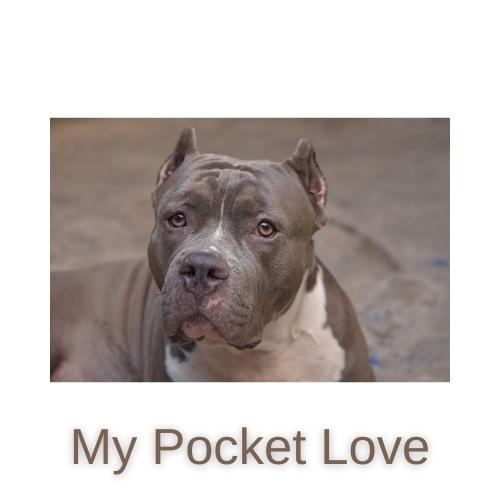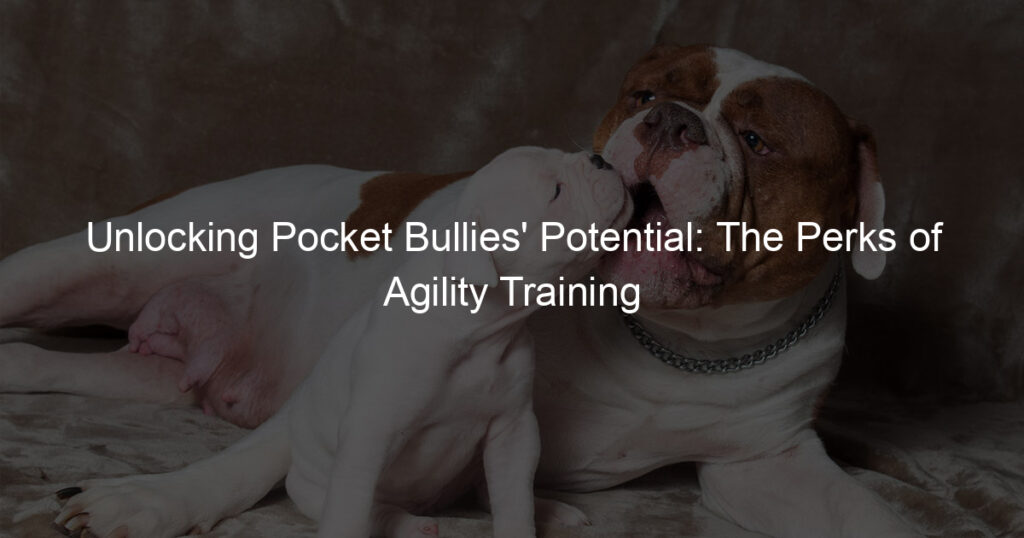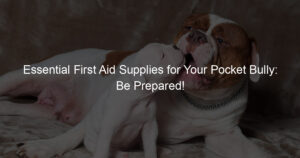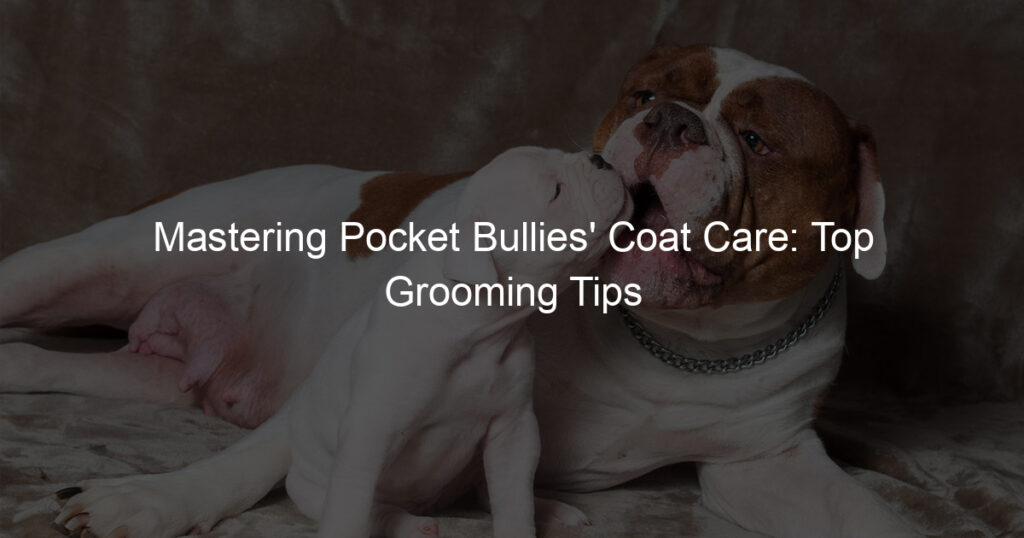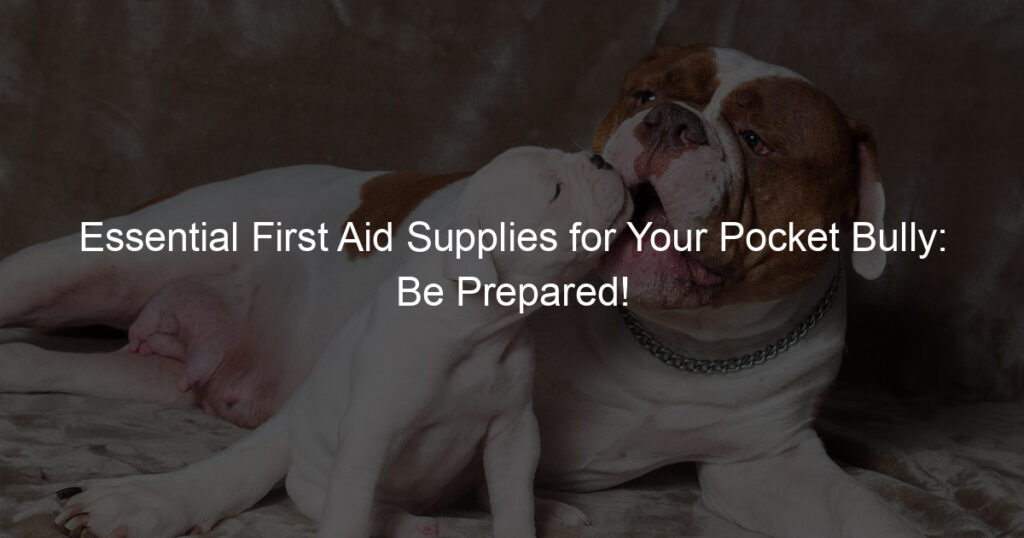
Introduction to Agility Training for Pocket Bullies
If you’re a dog owner, you’ve probably heard of agility training. It’s a fun and engaging way to exercise and bond with your dog. But have you ever considered it for your Pocket Bully? This breed, known for its strength and intelligence, is surprisingly well-suited to agility training. Let’s dive in and learn more.
- Understanding the concept of agility training
- Why Pocket Bullies are suitable for agility training
Agility training is a type of dog sport that involves a series of obstacles that your dog must navigate under your guidance. It’s like an obstacle course for dogs! They may have to jump over hurdles, weave through poles, climb ramps, and more. It’s a great way to challenge your dog mentally and physically, and it can be a lot of fun for both of you.
Pocket Bullies, despite their compact size, are known for their strength and agility. They are quick learners and eager to please, which makes them excellent candidates for agility training. Their muscular build allows them to tackle the physical challenges of the course, while their intelligence helps them understand and remember the commands and sequences. Plus, Pocket Bullies are known for their high energy levels – agility training is a great way to channel that energy in a positive way.
In the following sections, we will delve deeper into the benefits of agility training for Pocket Bullies, how to get started, and some tips and tricks to improve your dog’s agility. We will also share some success stories to inspire you. So, stay tuned!
Benefits of Agility Training for Pocket Bullies
Agility training is a fantastic way to keep your Pocket Bullies fit, mentally stimulated, and to strengthen the bond between you and your pet. Here are some of the key benefits:
- Improving Pocket Bullies’ Physical Health
Just like humans, dogs need regular exercise to maintain a healthy weight and overall good health. Agility training provides an excellent workout for your Pocket Bullies. It involves a lot of running, jumping, and weaving, which helps to build muscle strength and improve cardiovascular fitness. According to a study by the American Veterinary Medical Association, dogs that participate in agility training are less likely to suffer from obesity and related health issues.
- Enhancing Mental Stimulation
Agility training is not just about physical exercise. It also provides a great mental workout for your Pocket Bullies. The training involves learning new skills and following commands, which helps to keep their minds sharp. Dogs that are mentally stimulated are happier and less likely to develop behavioral problems. As the saying goes, “a tired dog is a good dog”.
- Strengthening the Bond Between Owner and Pet
Agility training is a team sport. You and your Pocket Bullies work together to navigate the course, which can help to strengthen the bond between you. Training your dog can improve communication, increase trust, and create a deeper connection. As the American Kennel Club points out, agility training is a fun and rewarding way to spend quality time with your pet.
In conclusion, agility training offers numerous benefits for Pocket Bullies. It can improve their physical health, provide mental stimulation, and strengthen the bond between owner and pet. So why not give it a try? Your Pocket Bullies will thank you for it!
Getting Started with Pocket Bullies Training
Training your Pocket Bullies can be an exciting journey. But before you embark on this adventure, it’s essential to understand your dog’s needs. This will help you tailor your training approach to suit your pet’s unique requirements.
Understanding Your Pocket Bullies’ Needs
Every dog is unique, and Pocket Bullies are no exception. To ensure a successful training experience, you need to understand your dog’s physical condition and temperament. Here’s how:
- Assessing your dog’s physical condition: Pocket Bullies are muscular and compact dogs. They require regular exercise to maintain their physical health. Before starting any training regimen, it’s crucial to assess your dog’s physical condition. This includes checking their weight, muscle tone, and overall health. If your dog has any health issues, consult with your vet before starting agility training.
- Understanding your dog’s behavior and temperament: Pocket Bullies are known for their friendly and outgoing nature. They are eager to please and respond well to positive reinforcement. Understanding your dog’s behavior and temperament will help you choose the right training techniques. For instance, if your dog is shy or anxious, you might need to start with basic commands and gradually introduce more complex exercises.
Understanding your Pocket Bullies’ needs is the first step towards a successful training journey. Once you have a good grasp of your dog’s physical condition and temperament, you can start choosing the right agility training techniques.
Choosing the Right Agility Training Techniques
When it comes to agility training for your Pocket Bullies, choosing the right techniques is crucial. This process involves three main steps:
- Starting with Basic Commands
- Introducing Agility Equipment
- Gradually Increasing the Complexity of Exercises
Before introducing your Pocket Bullies to agility equipment, it’s important to start with basic commands. These commands include ‘sit’, ‘stay’, ‘come’, and ‘down’. These commands lay the groundwork for more complex agility exercises. According to a study by the American Kennel Club, dogs that understand basic commands are more likely to excel in agility training.
Once your Pocket Bullies have mastered the basic commands, it’s time to introduce them to agility equipment. Start with simple equipment like tunnels and low jumps. Remember to always supervise your dog when they’re using the equipment to ensure their safety. According to a survey by the American Veterinary Medical Association, 85% of dogs that are introduced to agility equipment in a controlled and safe manner show a significant improvement in their agility skills.
As your Pocket Bullies become more comfortable with the agility equipment and exercises, you can gradually increase the complexity of the exercises. This could involve raising the height of the jumps, adding more obstacles, or increasing the speed of the exercises. A case study by the Canine Journal showed that dogs that are gradually introduced to more complex exercises have a higher success rate in agility competitions.
By following these steps, you can ensure that your Pocket Bullies are receiving the right agility training that suits their needs and abilities. Remember, the goal of agility training is not just to win competitions, but also to improve your dog’s physical health and mental stimulation.
Dog Agility Training: A Step-by-Step Guide
Training your Pocket Bully in agility is a rewarding process that can strengthen your bond and provide both mental and physical stimulation for your dog. Here is a step-by-step guide to get you started:
- Setting up the training environment
- Introducing the agility course
- Gradual training progression
- Consistent practice and reinforcement
First, you need to set up a safe and comfortable training environment. This could be your backyard, a local park, or even a dedicated dog training facility. Ensure the area is free from hazards and distractions. Use agility equipment suitable for your Pocket Bully’s size and abilities. This could include jumps, tunnels, and weave poles.
Once the environment is set, introduce your Pocket Bully to the agility course. Start with one piece of equipment at a time, encouraging your dog to interact with it. Use positive reinforcement such as treats and praise to reward your dog for successful interaction. Remember, patience is key during this stage.
After your dog is comfortable with the equipment, gradually increase the complexity of the course. Start by combining two pieces of equipment, then three, and so on. Always ensure your dog is comfortable and confident before moving on to the next level. This gradual progression helps build your dog’s confidence and agility skills.
Consistency is crucial in agility training. Regular practice helps your dog understand and remember the course. Reinforce positive behaviors and correct mistakes gently and immediately. Remember to keep training sessions short and fun to prevent your dog from getting bored or frustrated.
By following these steps, you can effectively train your Pocket Bully in agility. Remember, every dog learns at their own pace, so be patient and consistent. With time and practice, your Pocket Bully will become a confident and skilled agility athlete.
Improving Pocket Bullies Agility: Tips and Tricks
Improving your Pocket Bullies’ agility doesn’t have to be a daunting task. With the right approach and dedication, you can help your furry friend become more agile and healthier. Here are some tips and tricks to help you on this journey:
- Maintaining a Balanced Diet
A balanced diet is essential for your Pocket Bullies’ overall health and agility. It provides the energy they need for their daily activities and training sessions. A diet rich in protein helps build muscle mass, while carbohydrates provide energy. Vitamins and minerals are also crucial for bone health and immune system function. Always consult with your vet to create a diet plan that suits your dog’s specific needs.
- Ensuring Regular Exercise
Regular exercise is a key component in improving your Pocket Bullies’ agility. It helps build strength, endurance, and flexibility. Exercise should be a mix of both physical activities like running, jumping, and playing, as well as agility-specific exercises like weaving through poles or jumping over hurdles. Remember, consistency is key. Make sure your dog gets exercise daily, but also ensure they have time to rest and recover.
- Providing Mental Stimulation
Mental stimulation is just as important as physical exercise in improving agility. Training your Pocket Bullies to follow commands or solve puzzles can help keep their mind sharp and improve their focus during agility training. You can use toys, games, or training exercises to provide this mental stimulation.
- Regular Veterinary Check-ups
Regular veterinary check-ups are crucial to monitor your Pocket Bullies’ health and detect any potential issues early. Your vet can provide advice on diet and exercise, and ensure your dog is in the best possible health to participate in agility training. They can also provide vaccinations and treatments to prevent health issues that could affect your dog’s agility.
By following these tips and tricks, you can help improve your Pocket Bullies’ agility and overall health. Remember, every dog is unique, so what works for one might not work for another. Always consult with a professional to create a plan tailored to your dog’s specific needs.
Pocket Bullies Health Benefits from Agility Training
Agility training is not just a fun and exciting activity for your Pocket Bully, but it also provides numerous health benefits. Let’s explore some of these benefits:
- Improved Cardiovascular Health
- Enhanced Muscle Tone and Strength
- Better Mental Health
Just like humans, dogs need regular exercise to keep their hearts healthy. Agility training involves a lot of running and jumping, which can significantly improve your Pocket Bully’s cardiovascular health. This means a stronger heart and better blood circulation, which can lead to a longer and healthier life for your furry friend.
Agility training requires your Pocket Bully to use all its muscles. This can result in enhanced muscle tone and strength. A stronger dog is a healthier dog. Plus, this can help prevent injuries and keep your dog active and agile for longer.
Agility training is not just physically demanding; it’s also mentally stimulating. Your Pocket Bully needs to learn and remember the course, which can help improve its mental health. This can lead to a happier and more content dog, reducing the chances of behavioral issues caused by boredom or frustration.
In conclusion, agility training can be a great way to keep your Pocket Bully healthy, both physically and mentally. Not only will it help improve their cardiovascular health and muscle strength, but it can also contribute to better mental health. So why not give it a try? Your Pocket Bully will thank you for it!
Case Study: Canine Agility Training Success Stories
Let’s delve into some real-life success stories of dogs who have undergone agility training. These case studies will provide you with a clear understanding of the transformative power of agility training for Pocket Bullies.
- Case Study 1: From Couch Potato to Agility Star
- Case Study 2: The Transformation of a Shy Pocket Bully
Meet Max, a three-year-old Pocket Bully who was more interested in lounging on the couch than playing fetch. His owner, Sarah, decided to enroll him in an agility training program in the hopes of increasing his physical activity and overall health.
At first, Max was hesitant. The agility course seemed intimidating, and he was more interested in the treats than the training. However, with consistent practice and positive reinforcement, Max began to show significant improvement.
Within a few months, Max was not only completing the agility course but doing so with enthusiasm and speed. He had transformed from a couch potato into an agility star. His health improved, and he became more active and playful at home. This case study shows that with patience and consistent training, any dog can become an agility star.
Next, we have Bella, a shy and timid Pocket Bully. Bella’s owner, John, noticed that she was often anxious around other dogs and people. He decided to try agility training as a way to boost her confidence.
Initially, Bella was scared of the agility equipment and other dogs in her class. However, with gentle encouragement and gradual exposure, Bella began to overcome her fears. She started to enjoy the agility course, and it became a positive outlet for her energy.
After several months of training, Bella’s confidence had significantly improved. She was no longer the shy dog hiding in the corner. Instead, she was eager to participate in class and interact with other dogs. This transformation shows that agility training can do more than improve a dog’s physical health; it can also boost their confidence and social skills.
These case studies demonstrate the power of agility training. Whether your dog is a couch potato or a shy pup, agility training can help them become more active, confident, and healthy. So why not give it a try?
Conclusion: The Impact of Agility Training on Pocket Bullies
As we reach the end of our exploration into agility training for Pocket Bullies, it’s clear that this form of exercise has a profound impact on these small but mighty dogs. Let’s take a moment to recap the benefits and consider the potential of Pocket Bullies when they engage in agility training.
- Recap of the benefits of agility training
- Final thoughts on Pocket Bullies’ potential
Agility training offers a multitude of benefits for Pocket Bullies. It not only enhances their physical health by improving their strength, flexibility, and endurance, but it also boosts their mental well-being. The complex challenges presented in agility courses stimulate their minds, fostering problem-solving skills and reducing boredom-induced behaviors.
Moreover, agility training strengthens the bond between the dog and the owner, as it requires mutual trust and communication. It also provides an excellent outlet for the high energy levels of Pocket Bullies, helping them to maintain a balanced temperament.
Despite their small size, Pocket Bullies have immense potential when it comes to agility training. Their compact, muscular build allows them to navigate through agility courses with speed and precision. With proper training and consistent practice, they can excel in agility competitions, bringing pride to their owners and breed.
However, the potential of Pocket Bullies is not limited to agility training. These dogs are known for their loyalty, intelligence, and affectionate nature, making them excellent companions. With the right care and training, they can reach their full potential, becoming well-rounded dogs that are not only physically fit but also emotionally balanced.
In conclusion, agility training is a powerful tool that can help Pocket Bullies thrive. It offers numerous benefits and helps these dogs reach their full potential. So, if you’re a Pocket Bullies owner, consider incorporating agility training into your dog’s routine. You’ll be amazed at the positive changes it can bring.
